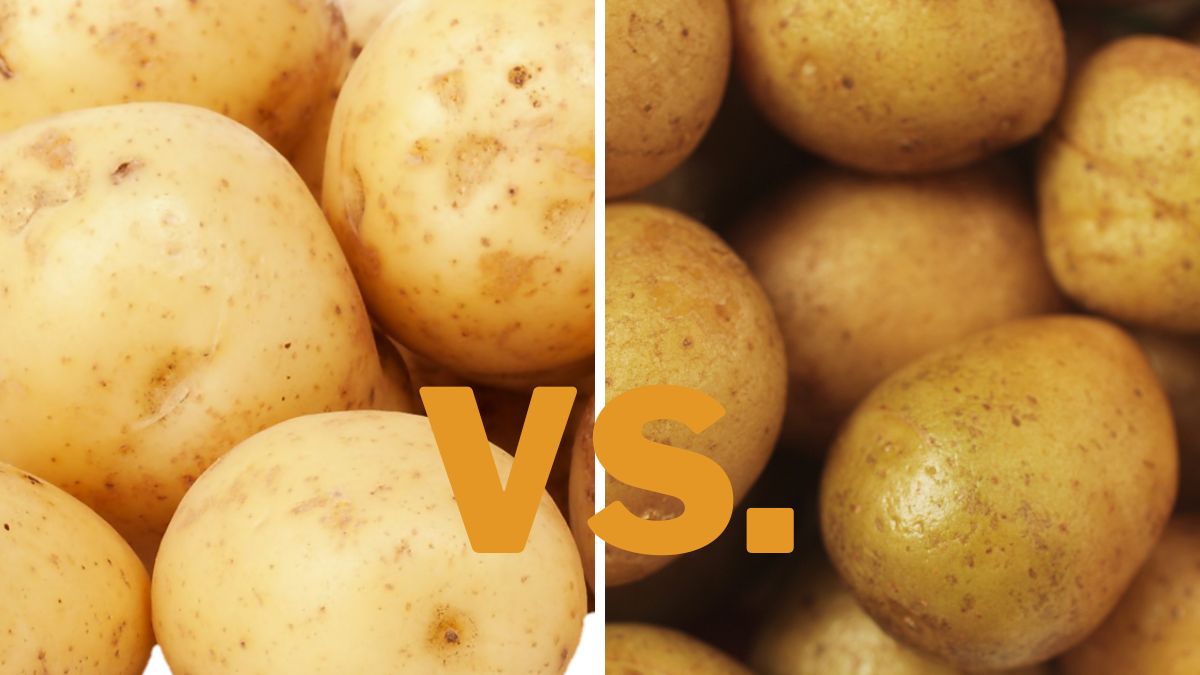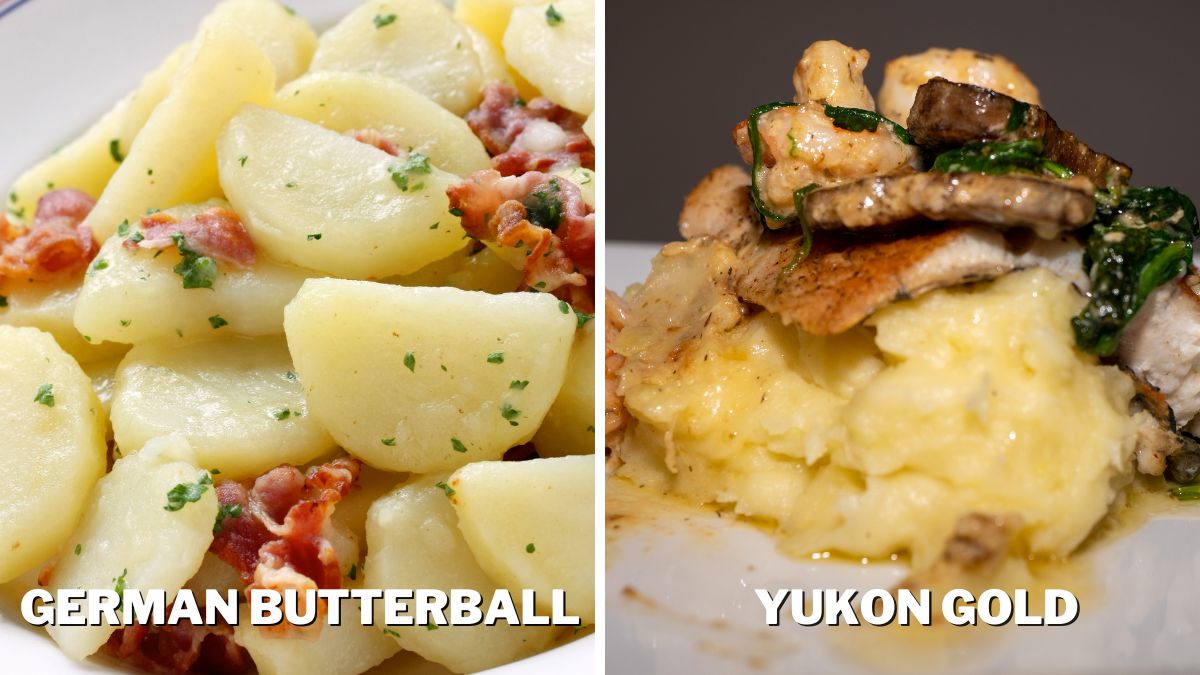German Butterball Potato vs. Yukon Gold: Differences & Uses

With their creamy yellow flesh and velvety skins, German Butterball and Yukon Gold are just irresistible. Even though I know that I really can’t go wrong with either of these buttery beauties, they are different, and I like to use them in the way that will best make each shine. So, what’s the difference between German Butterball and Yukon Gold?
The German Butterball has a starchy, fluffy texture, perfect for mashing. Its skin is thin, peels off easily, and melts in your mouth. The Yukon Gold has a creamy, waxy texture that holds together well for salads. Its golden skin is also thin but tends to cling more to the potato.
The battle may be over for now, but the war will rage on in kitchens everywhere as cooks continue the timeless debate over which of these two potatoes reigns supreme. Read on to discover which one better suits your needs!
Texture and Appearance
Regarding buttery potatoes, I’m always torn between German Butterball and Yukon Gold. They’re both so delicious but have some key differences. I prefer the lighter, fluffier German Butterball for mashed potatoes, french fries, or gratins. The denser Yukon Gold is my go-to for potato salads or home fries since it holds its shape better.
The pale yellow German Butterball looks more buttery, but the Yukon Gold’s yellow hue is more eye-catching.
German Butterballs have a smooth, creamy texture and pale yellow skin. Yukon Golds have a slightly waxy, firm texture and bright yellow skin with golden eyes.
The smooth and creamy German Butterball melts in your mouth, while the waxy Yukon Gold holds its shape better when cooked.
If you’d like to see how potatoes are harvested, here’s a great video showing the harvest of German Butterball potatoes!
Taste
When it comes to taste, these potato varieties are quite different. While the German Butterball lives up to its name with a decadent, buttery taste, the Yukon Gold has an almost corn-like sweetness and nuttiness in addition to its buttery notes.
The German Butterball has a rich, nutty flavor with creamy yellow flesh, while the Yukon Gold has a lighter, earthier taste with a hint of sweetness. Its flesh is also yellow but tends to be drier.
The German Butterball’s robust, savory flavor pairs well with heartier dishes like pot pies, gratins, and stews. It’s ideal for mashing since it produces a fluffier, creamier mash. The nutty, buttery notes also shine through when boiled, roasted, or baked.
The Yukon Gold’s balanced, mellow flavor is more versatile and complements a wider range of cooking methods and cuisines. It’s excellent boiled, steamed, or roasted and used in salads. The moderate starch content means it holds its shape when cooked, producing a firmer, waxier mash or salad.
Cooking Methods and Cooking Time
When it comes to cooking German Butterball and Yukon Gold potatoes, I prefer two very different methods. For German Butterballs, boiling and mashing are the way to go to highlight their creamy, buttery texture. Yukon Golds, on the other hand, are better suited to roasting and baking to bring out their natural nutty flavor.
German Butterballs were made for mashing. Their high starch content means they break down easily when boiled, turning into a smooth and creamy mash. I cut the potatoes into evenly sized chunks, leaving the skins on. Boil them in salted water until tender when pierced with a fork, about 15-20 minutes. Drain and return to the pot, then mash with a potato masher or ricer. Mix in butter, milk, or cream, and season with salt and pepper.
The result is a rich, decadent mash perfect for serving as a side with meat dishes or topping shepherd’s pie.
Yukon Golds have a waxy, nutty flavor that shines through when roasted or baked. I prefer to peel Yukon Golds before cooking to allow their flavor to develop. Cut into evenly sized wedges, toss with oil, salt, and pepper, and spread on a baking sheet in a single layer. Roast at 400 °F (200 °C), turning once, until tender inside and browned outside for about 25-30 minutes.
You can also bake Yukon Golds whole by pricking with a fork, rubbing with oil and salt, and baking until tender when pierced with a knife, about 50-60 minutes. Baked or roasted Yukon Golds pair well with roast chicken, grilled steak, or fish.
Best Uses

The German Butterball has a creamy, waxy texture that breaks down quickly when cooked, turning into a rich, silky puree. Its high starch content means it won’t get gummy like a russet. I only need to add a bit of butter, milk, or cream, and salt and pepper when making mashed potatoes.
They taste rich and savory on their own but also absorb other flavors well. I like to mix in cheese, chives, bacon, or caramelized onions.
The German Butterball is also ideal for baking with its creamy texture and mild flavor. It makes fluffy potato pancakes, gratins, and scalloped potatoes. When baked, its flesh turns soft and custardy. I also like to add German Butterballs to shepherd’s pie, cottage pie, and pot pies.
On the other hand, the Yukon Gold, with its waxy, moist flesh and earthy, nutty flavor, is better suited for gourmet potato dishes. It holds its shape when cooked, ideal for potato salads, home fries, and gratins. The Yukon Gold is also vibrant yellow, making dishes look more appetizing.
Which of the two is your ultimate favorite, and in which dishes do you like it best? Excited to read your thoughts in the comments below!
